INTERREG-A: protectAlps
Alps, persistent pollutants and insects

In cooperation with German and Austrian project partners, the LfU determines the concentrations of persistent chemicals on insects in alpine regions. Our intention is to create standards and general conditions for a common, cross-border approach to protect the alpine biodiversity.
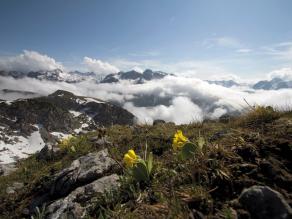 Flowers at high altitudes of the Alps show the important role of pollinating insects; Picture: Nationalpark Berchtesgaden
Flowers at high altitudes of the Alps show the important role of pollinating insects; Picture: Nationalpark BerchtesgadenBackground: insects and chemical stressors
The abundance of insects has declined strongly in recent years. There are various causes for the decline in number of insect species and biomass, including the intensification of agriculture and the use of fertilizers and pesticides. A possible reason for a decline, also in areas far from agricultural areas, are ubiquitous pollutants. Especially, hardly degradable, chemical pollutants which undergo long-range transport are possible factors which influence the abundance of insects. These pollutants are called persistent organic pollutants (POP).
POPs include certain internationally regulated pesticides such as DDT and industrial chemicals such as brominated flame retardants. These chemical stressors can accumulate in the organism of insects and are considered toxic. The influence of POPs on insects in the Alps is not known yet and no data is available.
Although the Alps are generally far away from industrial areas, they are also affected because of condensation effects, which increase the entry of these pollutants in cold areas with high precipitations rates. This means, that the Alps ecosystems are polluted even at lower air concentrations.
In addition to persistent organic pollutants, which are able to affect the insects directly, the input of nitrogen changes the composition of plant communities. This has an indirect impact on the occurrence of insects in alpine regions. Nitrogen compounds are emitted from traffic and agriculture and are transported via the atmosphere.
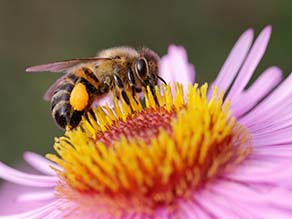 Insects play an important role for the entire ecosystem © Ludmila Smite - fotolia.com
Insects play an important role for the entire ecosystem © Ludmila Smite - fotolia.com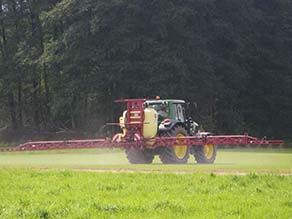 Certain plant protection products as well as nitrogen from traffic and agriculture are suspected to have a negative influence on insects even in alpine regions Foto: Erwin Attenberger
Certain plant protection products as well as nitrogen from traffic and agriculture are suspected to have a negative influence on insects even in alpine regions Foto: Erwin AttenbergerObservation of chemicals in the Alps
The starting point for protectAlps are measurements of air concentrations of POPs in the Alps. These are carried out since 2005 with a number of projects. The most recent example is PureAlps.
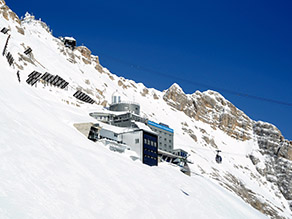 The Schneefernerhaus Environmental Research Station on the Zugspitze mountain; Picture: © M.Neumann UFS GmbH
The Schneefernerhaus Environmental Research Station on the Zugspitze mountain; Picture: © M.Neumann UFS GmbHThe measurements of the ambient air concentrations are carried out on Zugspitze mountain in Bavaria and Hoher Sonnblick mountain in the national park Hohe Tauern in Austria (Environmental Research Station Schneefernerhaus, UFS and Sonnblick Observatory, SBO).
For an exact comparison of the measured values, the methods on the Bavarian and Austrian side have been coordinated since the project MONARPOP (2005). For mountains in mid-latitudes, these series of measurements are unique.
Direct effects of chemicals on insects
In order to get information about the influence on the insects, suitable species on both sides of the border are defined. After catching these target species in field campaigns, they are analyzed for POPs in ultratrace laboratories.
At the University of Innsbruck, irregularities in the morphology of insects are investigated by measuring characteristic structures for example the wings. Differences between actually symmetrical parts of the body are regarded as an indication of influence on the animals due to stressors. By default, at the University of Innsbruck genetic causes of asymmetries in the body parts are investigated. It may be caused by inbreeding in populations with only a few individuals. If genetic causes can be excluded, it is possible that pollutants are the reasons for asymmetries.
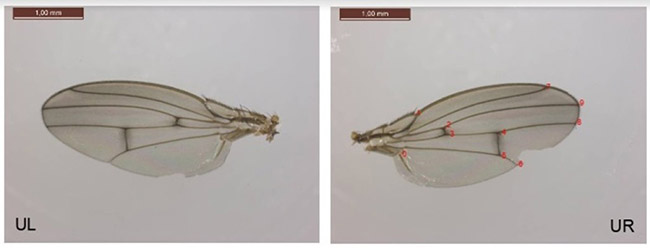 Measuring of characteristic structures shows the influence of chemical stressors on insects; Picture: Marlene Haider
Measuring of characteristic structures shows the influence of chemical stressors on insects; Picture: Marlene HaiderIndirect effects of nitrogen
Nitrogen plays a central role in the nutrient supply of plants. In the course of their evolution, many plants have adapted to a lack of plant-available nitrogen compounds. However, with nitrogen releases from road traffic and agriculture, humans are massively intervening in the nitrogen cycle. The result is that even in remote areas more nitrogen gets available for plants. As a result, the plant communities are changing towards species for which higher nitrogen contents are particularly favorable.
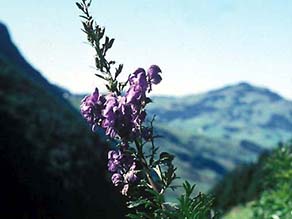 The genus Aconitum is one of the plant genera that are essential for an insect species. Only where Aconitum occurs the Aconitum-bumblebee (Bombus gerstaeckeri) can exist; Photo Dr. Walter Joswig
The genus Aconitum is one of the plant genera that are essential for an insect species. Only where Aconitum occurs the Aconitum-bumblebee (Bombus gerstaeckeri) can exist; Photo Dr. Walter JoswigThe insects are indirectly affected by the nitrogen inputs, because many species of insects are specialized in a few plant species.
Long time- series of measurements in remote areas are necessary to measure long-term trends in the input of nitrogen compounds from air.
Within the project protectAlps, measurement of ambient air concentrations of nitrogen compounds on Zugspitze mountain and Hoher Sonnblick mountain will be harmonizised and long-term trends in air concentrations will be calculated. The trends should finally be compared with changes in plant vegetation..
Project partners
On bavarian side, Bavarian Environment Agency (LfU) and the Environmental Research Station Schneefernerhaus (UFS) on the Zugspitze mountain are involved in the project. Project partners from Austria are the Leopold-Franzens-University of Innsbruck with the Institute for Ecology (Prof. Birgit Schlick-Steiner) from Tyrol as well as the Sonnblick Observatory Hoher Sonnblick (SBO) in Salzburger Land. The Sonnblick Observatory is managed by the Austrian Central Institute for Meteorology and Geodynamics (ZAMG).
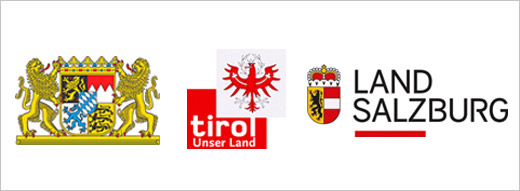
Funding
The project is funded by the European Union within the INTERREG A program under the title "Project for the valuation of chemical stressors for the protection of alpine biodiversity with a focus on insects" and the project number AB173.
The project is cofinanced by the Bavarian State Ministry for Environment and Costumer Protection (StMUV) and the ZAMG (Austria).
Contact
If you are interested in the project, please contact:
Bavarian Environment Agency, Evaluation of Substances and Chemicals
Veronika Hierlmeier, Tel.: +49-(0)-821/9071-1292, Veronika Hierlmeier
Dr. Korbinian Freier, Tel.: +49-(0)-821/9071-5375, Dr. Korbinian Freier
Further information
Links
- Funding programm INTERREG
- Project partner Schneefernerhaus on the Zugspitze mountain
- Project partner Sonnblick Observatory
- Projektpartner Leopold-Franzens-University of Innsbruck- Molecular Ecology
- Pressrelease of the Bavarian State Ministry for Environment and Consumer Protection
- Project PureAlps – Monitoring of Persistent Organic Pollutants in the Alps

